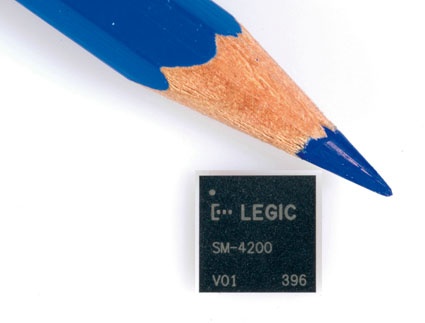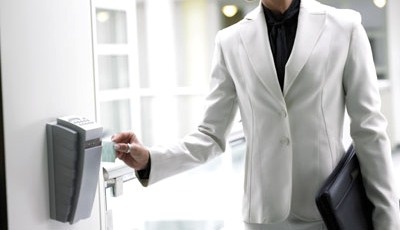Urs A. Lampe: Contactless Card Technology
The name Legic is synonymous worldwide with quality contactless ID technology and smartcard systems for person-related identification in both business and leisure applications. Mul...



The name Legic is synonymous worldwide with quality contactless ID technology and smartcard systems for person-related identification in both business and leisure applications. Multi-applications, the convergence of offline and online applications, low-power solutions, security and multi-technology solutions are all topical subjects in smartcard technology. Matthias Erler of GIT-SECURITY.com spoke with Urs A. Lampe, Vice President Product Marketing & New Business, Legic Identsystems.
Mr. Lampe, Legic can meanwhile look back over 20 years since its foundation - that still makes it a young company but it is an eternity in the development of security technology. Looking at the subject of access control, what are the latest developments here compared to earlier?
Urs A. Lampe: Broadly speaking, it is certainly the 13.56 MHz contactless technology that has established itself as the preferred technology during this time. The market has recognized the advantages of this technology: it makes things easy because you no longer have to take something out of your wallet, and also provides higher security and flexibility compared to the traditional technologies like magnetic strips or inductive passes. A further significant development is the subject of multi-applications - that means that you can independently serve many different applications with just one credential. Of particular note are the new capabilities in the field of battery-operated lock applications. A small revolution has been going on for a few years because of the networking ability via the cards and new power-saving processes. In addition to the ISO standardization we are also seeing a trend to products with improved security.
Let‘s take a closer look at the multi-applications: which applications are used here in general?
Urs A. Lampe: This trend could be seen earlier in Europe and Asia, and now increasingly in the USA. In principle, it‘s about automating whole work processes and also leisure activities and raising them to a new level of convenience. An access control credential can for example be used to operate a printer or a photocopier - equally to rent a bicycle or to open a company car. It is remarkable to see the convergence, the blending of applications from the contactless world with those from the contacted world, such as in IT: „Contactless meets contact".
Can you give us an example?
Urs A. Lampe: Physical entry, that is, in conjunction with a door, is being enabled with the same credential that is used for access to a PC. You can organize access and Windows logon using the same card. That is indicative of the trend to extend the use of microprocessor-based ID media to higher value applications, but also to use them in other forms: for example USB sticks or mobile phones with the NFC standard are being used that have a contactless interface. These microprocessors can also be the platform for others - for example, as the SIM card of a telephone or smart phone. In summary, convergence is a priority for three market segments: physical and logical access in companies, that is, logon to Windows together with access control; in leisure and banking such as access to leisure facilities using contactless credit cards; the use of a telephone for contactless applications in the leisure or business segments. These open up totally new opportunities and business models.
How is the use of platforms by others made possible technically?
Urs A. Lampe: We have adapted our products to these developments by developing virtual transponders that can be loaded onto smartcard platforms or others but that allow the use of applications like a conventional Legic card. This is then like an integrated Legic card, but on a foreign platform. We call these ‚card-in-card‘ solutions. For smart phones there are corresponding apps that are used in the SIM card. The platforms used are mostly powerful and certified microprocessor smartcards and count among the most secure solutions.
Are the security requirements altering in the area of access control?
Urs A. Lampe: As on the one hand the technical capabilities have changed and on the other hand the environment in which we move has changed, more importance is being placed on security and how this is made available. We see a move towards the methods and procedures of IT security. The technologies also adapt with regard to the attacking situation. There is a visible trend toward open and certified security in our industry that is getting increasingly closer to the IT security standards. We have noticed, in particular with large companies, that we now talk to more people from the IT section of the company. In practice this means that the ability to update and the encryption technology are playing a more important role. For that reason, our new Legic advant 4000 reader chip series can be updated in the field to be adaptable in the future. This has been standard practice in IT for some time.
What is happening exactly under the headline of ‚Revolution‘ in offline access control?
Urs A. Lampe: Here we are talking about the possibility to connect offline access control applications using contactless technology. Above all this concerns battery-driven, non-cabled door locks or barriers. They are operated ever more frequently without contacts because they can nevertheless be networked with the background system. There is a trend towards offline together with online access control. Metal keys are mostly used at conventional widespread access points - it would require too much effort to subsequently install electronic locks, in particular because of the cabling. It was therefore only done at selected points. Now it is possible to do this without cables in the form of a virtual network. At the main entrance the authority, for example, to open a particular cabinet is written onto the card. If it is opened, this is recorded and the cabinet writes its user log or even the battery condition onto the card in the same process. The next time this card is used at the main entrance, this information is read out and centrally managed. The cabinet is without any cables, but networked nevertheless. In this way, new access control concepts can be more quickly and accurately implemented. That improves convenience and security and simultaneously reduces the operative costs, not least because the cabling is not required, but also because there are no lost keys, no troublesome exchange of locks, the authorizations can be easily altered and there is the option to block certain doors.
Energy consumption: the market demands ever lower-power solutions. What is driving this and what do you have to offer?
Urs A. Lampe: One of our most important products in our traditional core market is contactless door locks. They form a natural part of an access control system. For this reason we have taken another step. We introduced our new Legic advant 4000 reader chip series for the first time at the Security trade fair in Essen. It has been specially developed for battery-driven devices. It is a low-power solution which gives the devices a very long life.
How does that work technically?
Urs A. Lampe: A large portion of the energy is used, for example in a lock, to check if a card is nearby. This checking procedure uses an electric field that needs power to be established. The technical trick involves carrying out this check as efficiently as possible, but nevertheless ensuring detection as soon as a card gets close to the lock. We have patented a ‚wake-up‘ function that enables our reader chips to use 60 % less energy. This ensures a long battery life, and thereby also a reduction of maintenance costs because the batteries are smaller and do not need to be replaced so often. In addition, the new Legic advant 4000 reader chips are so small that they fit in almost every existing door - for example, furniture doors and medical cabinets - which simplifies a subsequent change to contactless technology. The new technology is also significantly more economic which means that more such locks are being installed, leading to lower production and purchase costs and extending the areas of application still further.
One last subject: multi-technologies. How important is this for you?
Urs A. Lampe: Various standards have been established around the globe. It is of course the wish of manufacturers to have just one design for all the various technologies. The customer should however also have the choice between the specific benefits of all the various standards. The reader should be able to read everything, and be able to process different formats, technologies and card populations. We can do that with our new Legic advant 4000 series and distinguish ourselves once more in the market. This technology allows itself to be updated and can later learn new standards.
Business Partner
Legic Identsystems AGBinzackerstrasse 41
8620 Wetzikon
Switzerland
most read

Assa Abloy's battery-powered Aperio KL100 secures lockers
Boost workplace security and operational flexibility by securing more than just doors.

VIP-Lounge Interview: Marco Mille, Global Head of Security, Siemens AG
VIP in the World of Security: Marco Mille, Global Head of Security at Siemens AG

Integrated and Futureproof: Traka’s Next Chapter
Interview with Stefni Oliver on Traka’s Vision for the Future

What Does Ethical AI Governance Look Like in Practice?
The InCyber Briefing will explore AI, post-quantum readiness, data sovereignty, and crisis simulation








